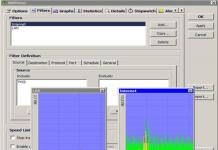Hello! We continue to disassemble the Windows 10 operating system! Today you will learn how to adjust the volume on a Windows 10 computer. You will be able to adjust the volume of the speakers and system sounds. To adjust the volume, open the Start menu at the bottom left of the screen. In the window that opens, in the list of all applications, at the bottom of the list, open the “Windows System” tab. Next, in the list that opens, click on the “Control Panel” tab.


Next, the “Volume Mixer” window will open. Here you can adjust the volume of the main speakers and the volume of system sounds. Note! System sounds can be configured separately from speaker sounds. That is, system sounds can be made louder or quieter than the sound of the speakers.

Next, you can also configure the sound through the taskbar. At the bottom right of the screen, in the taskbar, right-click on the volume indicator icon. In the window that opens, you can use the following functions:
Open the volume mixer.
Playback devices.
Recording devices.
Detect audio problems.

Problems with sound on your Windows 10 computer? Read Here!!!
Still have questions? Write a comment! Good luck!
Setting the volume on a Windows 10 computer updated: March 1, 2017 by Ilya Zhuravlev
info-effect.ru
How to set up speakers on a Windows 7 computer
Any new device requires some configuration, for example, adjusting sound parameters. All models that are on the market today are equipped with a built-in sound card. 
As a rule, most ordinary users are completely satisfied with the characteristics, quality and range of configurations of a discrete system. Sound lovers for whom it is important to achieve maximum results buy a separate card with additional settings and capabilities.
Regardless of the hardware of the device, every modern user should know how to set up speakers on a Windows 7 computer.
Standard Options Add-on
When you install Windows 7, it automatically configures all systems on your computer. If for some reason the process was interrupted or did not produce the desired result, you need to go to the “Device Manager” panel and make sure that the necessary components are active and that all drivers are available.
When an icon with an exclamation mark is lit next to the speakers, it means that there are no drivers (you need to download the files from the official website, then install them on your computer).

When there is a red cross next to the audio player icon, this indicates that the device is not active. To enable it, you need to right-click on the icon and activate the “Enable” field. Evidence that the normal and speaker settings are enabled is the speaker located in the right corner at the bottom of the Windows 7 desktop.
Next, you need to adjust music playback on your PC. To do this, go to the Start menu, then to the Control Panel. 
Here you will find “Sound”. All further actions are performed in this section.
In the “Sound” section you need to find the “Playback” menu and click on “Customize”. A window will open in which you can check whether the speakers are sounding correctly by clicking on the picture of the speakers.
Carefully check that all speakers are working correctly and click “next”. Another window will open where you need to check the line of parameters for wide and surrounding formats (when available). Then comes “next” and “done.” This is the final step and completes the usual speaker tuning.
For convenience, you can calibrate sound effects for playback on a PC. In the same “Sound” section in the “Playback” menu, find the speaker and click on “Properties”. In the window that appears, the “General” menu displays the available inputs; in “Levels,” a convenient volume scale for playback through speakers and microphone recording is adjusted.
In “additional features” you can select, activate or delete unnecessary options. After selecting the parameters, it is important not to forget to save everything and click “Ok”.
Adjusting sound on a laptop
Adjusting the parameters on a laptop may differ slightly from a PC. The fact is that, unlike a stationary model, a laptop only has integrated speakers for playing music. Despite the differences in equipment, the process diagram on the devices is similar.
- First you need to go to the Start menu.
- "Control Panel".
- "Sound".
In the last section, the same steps are performed as in the case of a PC.
Laptops have an unusual but convenient “Fn” key on their keyboards. It is not difficult to find; it is usually located near the Windows button. Examine the keyboard carefully; some keys (located at the top) have different symbols.
To configure, you will need to find the speaker icon. If you simultaneously press “Fn” and the button with the speaker crossed out, the sound on the device will turn off. Using similar keys (arrows are drawn) you can change the playback level. There is nothing difficult in the adjustment process.

How to set up speakers on a Windows 7 PC programmatically
Adjusting playback on a PC is done not only using standard methods. Often, audio equipment developers implement special programs - software. They are used to make detailed playback adjustments.
The most famous option is Realtek. This program serves as the standard option for advanced adjustments in Windows 7.

To open the programs, enter “Realtek HD” in the system search engine and press enter. In this software, all the points are collected in a single menu to simplify the process. The types of inputs and active devices are also displayed here.
The volume is adjusted by moving the slider, and next to it is changing the balance of the speakers. Select convenient parameters from the additional list, then immediately listen to the finished result. Next, go to the “Sound Effect” menu.
Here the general environment is adjusted, and in the “Equalizer” section you select the genre to play. Carefully adjust everything to suit yourself and save the result. The microphone configuration is carried out in the same software.
Using such programs greatly simplifies the process.
In essence, there is no big difference between the configuration of a laptop and a PC. All devices on the same system are similar. The entire process is performed in the same way, with the exception of some nuances.
The most convenient method of adjusting playback is to use additional software from the developer. It is usually installed along with the drivers. The advantage of such programs is that everything is collected in one section.
This approach is much more convenient. Searching for the required parameter in standard tools is more difficult, and everything will take more time.
In most cases, modern built-in maps allow you to not bother yourself and use automatic configuration. It produces good results for the music being played.
The end result is quite enough for most everyday tasks of an ordinary person. Most users only use volume control, but some people want the sound quality to be as high as possible.
They try to squeeze everything out of the device and make optimal configuration adjustments, to squeeze everything they can out of their device.
vacenko.ru
How to adjust sound on a computer in Windows 7?
Loss of sound on a computer is one of the most common problems, which all PC users have experienced at least once. There can be quite a few reasons for this, but often the user himself is to blame for setting up the sound incorrectly, or simply messing up the settings.
The problem with setting up sound on Windows 7 is especially pressing for those users who have been using Windows XP for a long time, because the settings in the updated version actually look and function a little differently.
But solving this problem can be much easier than it seems at first glance. To do this, you should carefully follow the step-by-step instructions.
So let's get started:
1) First you need to click on the small image of the speaker, which is located in the lower right corner of the monitor with the right mouse button, select the “Playback devices” section.
2) In the window that appears, you need to carefully check that the headphones and speaker are active.

3) If you do not find the desired device in the list provided by the PC, check the connection of the device to the computer. Next, right-click on an empty area and select “Show disabled devices.”

4) If the device you need is not working, then you need to select the “Enable” option, and everything will work as usual.
5) If you double-click on the icon, a window will open with which you can make all the necessary settings and check if the speakers are working. You may have to configure the speakers using the settings wizard (for 5.1 and 7.1).
With the help of these instructions, you will make the maximum settings that your PC requires.
Another common reason why sound may not work or not work correctly is that the service that is responsible for playing audio files is disabled. To resume its operation, go to Control Panel - Administrative Tools - Services, and select “Windows Audio” from the list.
If it is really not active, click on it with LMB, and in the window that opens you can change the parameters and start the selected service.
After resetting the settings, in the same window you need to select one more parameter - startup type, it should be defined as automatic. This means that the service will turn on automatically when you boot your PC, and you won't have to turn it on yourself every time.
pced.ru
How to install and configure computer speakers
Good sound is an important component of computer performance. Audio playback is required not only for games and movies, but also for interaction with some music programs. Therefore, you need to know how to connect speakers to a computer so that the sound remains of high quality and satisfies the user’s needs.
The initial sound setup on a personal computer or laptop begins with installing drivers for the sound card. Of course, the latest modern operating systems, such as Windows 10, are themselves able to determine the model of the sound device, regardless of whether it is built-in or separate, and install the necessary supporting software. Of course, this option is not suitable for owners of sound cards that were released recently.
Typically, a built-in sound card is used to connect speakers. Modern boards support a six-channel system. It is enough to connect a 5.1 stereo system, but if you want to enjoy professional sound with a 7.1 system, you will have to think about buying an external sound card.
If the OS does not install the drivers automatically, then do not despair. We need to start from the very beginning, namely, to understand exactly what sound card is installed on your personal computer. They exist in three types: 2.1, 5.1, 7.1. At the very beginning, when installing special drivers, you can easily determine this using pop-up tips. And depending on the type of sound card, you can start setting up the sound on your computer, knowing what sound you should get as a result.
Connecting acoustics
Simple 2.0 (two speakers) and 2.1 (subwoofer, two speakers) systems are connected using a single cable, which is connected to the green connector.
A 5.1 system already requires three audio outputs:
- green – for front speakers;
- black – for rear speakers;
- orange – for the subwoofer and center speaker.
First, you need to turn off the computer, completely disconnecting it from power. Then connect the speakers to the connectors that match the colors of the cords. Line Out may be written on the connector.
Choosing a place for speakers
To position the speakers, you need to choose the right place where the sound from the speakers will be most pleasant to listen to. The favorable distance that should be between two or more speakers on a computer should be at least 1.5 meters or even more. If the speakers are located close to each other, their sound will be blurred and thus the result will be poor quality sound.
It is recommended to place the speakers on a table or other devices, but not on the floor; the floor can muffle and distort their sound, this does not apply to the subwoofer. The ideal height of speakers from the floor is considered to be from 1 to 2 meters. As for the subwoofer, its best sound will be heard if it is placed on the floor, because it is known that low frequencies are well perceived on a perfectly flat and hard surface. If your subwoofer has small speakers, then it is best to install it between the left and right front speakers, about a meter in front of them.
If you decide to place the speakers not on the table near the monitor, but to hang them, for example, on the wall, remember certain rules. If the speakers are small and light in weight. Then they will not need additional insurance, but in the case of heavy speakers, the weight of which can reach 5 kg, it is worth taking care of special safety brackets in order to avoid unpleasant situations. If you made no mistakes during installation, then the speakers on your computer should sound as smooth as possible, but if one speaker sounds louder than the other, you should adjust their sound using a subwoofer or software.
Connecting Bluetooth speakers
If you don’t want to limit your movements to speaker wires, choose Bluetooth devices. They work not only with laptops and PCs, but also with phones, so purchasing them becomes a very profitable investment.
Bluetooth speakers are not very powerful, but connecting them is quite simple:
- Turn on the speakers yourself. The LED indicator should light up.
- Turn on Bluetooth on your laptop or PC (if there is no built-in adapter, you can purchase a detachable one).
- Start searching for new devices.
- Find the name of your speakers and make a connection between the devices. Some models require you to enter a password to connect.
- If the connection is successful, the indicator will blink or change color.
- Turn on the music and enjoy the sound.
Today, computers are used in many aspects of our daily lives. Each person has his own priorities when using a computer. But even those who use a computer to print documents are not averse to listening to music from CDs or from the Internet, what can we say about those who play games, watch movies and, even more so, listen to music. In order to enjoy the sound, you need the correct sound settings on your computer.
Yuri Alisievich, Trade portal Shop.by
shop.by
How to restore sound on a computer


- Published: May 24, 2016
- Modified: August 21, 2017
- Views: 3,018
Sound is an integral part of the perception of information when working at a computer. Games, programs, movies - everything that runs on a computer has sound. Working with a number of applications without sound is impossible or simply inconvenient. Sound drivers are installed automatically along with the motherboard software. The Windows 10 operating system automatically installs drivers when you first start the computer, but it does not always do it correctly. Sometimes the sound on your computer may disappear for no reason at all, even if it previously worked normally. In most cases, you can solve a sound problem yourself, and below are ways to do it.
Checking the audio device
 Before you begin software setup of your computer, you need to make sure that the lack of sound is not due to a malfunction of the speakers or headphones. Connect another audio playback device to the computer and make sure that it also does not work, or, conversely, try connecting headphones or speakers to a smartphone, tablet or other computer to check their serviceability.
Before you begin software setup of your computer, you need to make sure that the lack of sound is not due to a malfunction of the speakers or headphones. Connect another audio playback device to the computer and make sure that it also does not work, or, conversely, try connecting headphones or speakers to a smartphone, tablet or other computer to check their serviceability.
Often the sound disappears for no reason precisely because of a malfunction of the sound playback device. For example, the wire through which the signal is transmitted may fray or break, or the elements on the speaker board may fail due to overvoltage.
If, as a result of the check, it was determined that the sound does not work precisely because of the computer, you can proceed to the next steps of the instructions.
Sound failure due to driver issues
 As mentioned above, drivers for setting up sound on a computer are installed along with the motherboard drivers. Even if a sound icon is displayed on the notification panel, it is far from certain that the drivers were installed correctly. When you first start Windows 10, the operating system automatically selects drivers from its library and installs them for all elements of the computer. If after this there are problems with the drivers, they need to be reinstalled to the versions recommended by the manufacturers.
As mentioned above, drivers for setting up sound on a computer are installed along with the motherboard drivers. Even if a sound icon is displayed on the notification panel, it is far from certain that the drivers were installed correctly. When you first start Windows 10, the operating system automatically selects drivers from its library and installs them for all elements of the computer. If after this there are problems with the drivers, they need to be reinstalled to the versions recommended by the manufacturers.
To reinstall the sound drivers you will need:
- On the computer. Determine the model of the motherboard used in the computer. Next, you need to go to the motherboard manufacturer’s website, find your model and download the latest drivers for Windows 10.
- On a laptop. Find out the laptop model, go to the manufacturer’s website and download the necessary drivers.
Note: If you still have a disk with drivers from your motherboard or laptop, you can try installing the software from it. But it is important to understand that during the time that has passed since the purchase of the device, the drivers may have been updated more than once, and the most current version is available on the manufacturer’s website.
Problems with sounds due to incorrect settings
When reinstalling drivers does not help solve the problem with sound playback on Windows 10, you need to make sure that the settings are correct. To check the audio output settings from your computer, you will need to do the following:

After completing all the settings, restart your computer, after which the sound problems should disappear.
Sound card disabled in BIOS
In the BIOS it is possible to disable the sound card built into the motherboard. This may be necessary, for example, if you are using a professional external sound card. When connecting speakers to a computer as standard, the sound card must be activated in the BIOS.
Problems with sound in Windows 10 have been known since the first days of working in the environment of the new OS originally from Redmond. Today we will try to consider all aspects of problems that arise with the reproduction of audio information: from hardware problems to reinstalling drivers and correct configuration of system audio parameters.
Hardware problems
Problems can arise for several reasons, some of which may be:
- Old audio cards. By installing Windows 10 on an old computer or laptop, you can become a victim of a serious Microsoft flaw. The developers of the “ten” did not introduce support for very old devices, which included sound cards. If you are the owner of a fairly outdated computer, then visit the Microsoft website and look to see if your audio card is in the list of supported ones.
- Malfunction of audio playback devices, ports, wires. We check whether the device functions to play sound on another device. Carefully inspect the audio ports for oxidation, visible physical damage, and check the integrity of the cables connecting the speakers or headphones to the sound card.
- Front panel connectors are faulty. This is relevant for PC users whose devices have pins on the front panel of the case. They should make sure that the ports on the front panel are working and active, which is checked in the BIOS.
Software sources of the problem
- old drivers;
- incorrect audio playback settings;
- CPU load;
- use of sound effects at the driver level.
Audio stutters and cuts out
Users often experience that the sound played through any player or browser stutters. There are two sources of such PC operation:
Zero volume
Due to the fact that the volume on the computer is reduced to 0, the user does not hear anything while playing something. In this case, the speaker icon in the tray is crossed out. Click on it and increase the parameter to the desired value.

Incorrect settings
Due to the presence of several devices for reproducing audio information, including a virtual audio device, the system may transmit digital data to the wrong device that the user needs. The problem can be solved simply:

If the required equipment is not detected, then do the following:

Audio effects
Software filters can cause noticeable audio distortion, which can make the user feel like the sound on a Windows 10 computer is wheezing. You can get rid of this distortion in the output signal by deactivating audio filters:

In a similar way, setting up sound in Windows 10 is done through Realtek HD Manager when using an audio card from and having the "" utility:

Audio format changes
The sound may be distorted if the wrong audio output format is used. It can be changed using Windows 10 and through Realtek Manager:

Or we do the same thing through Task Manager. In the " Standard format“Select also studio quality or click on the DVD Format button. 
Monopoly mode
When activated monopoly regime Audio may be momentarily interrupted. To solve this problem, let's perform the following sequence of actions:

System sounds actually absent. Microsoft has stopped voicing most actions in the system. Still, check if all Windows 10 sounds are disabled, and you can use them like this:

Another cause of wheezing sound
Another reason, known to many, why the sound can wheeze is increased sound volume, especially when playing music with a significant low frequency (LF) component, in this case available in the form of a frequency of less than 100 Hz.
Basically, the source of sound with such frequencies are drums. Most regular desktop and laptop speakers are mid- and high-frequency devices and are not designed to reproduce low frequencies at high volumes.
There are three methods to overcome wheezing in this situation:
- The easiest way is to reduce the sound volume.
- Reduce the proportion of low frequencies using the system equalizer or the player's equalizer.
- If you are a fan of the sound of drums and other low-frequency musical instruments, then of course we recommend purchasing more powerful playback equipment that includes subwoofer, designed for high-quality playback of low-frequency sounds.
To call the Windows 10 system equalizer, you need to work with the previously mentioned Sound system utility:
Sound → Playback tab → Speakers → Properties → Enhancements → Equalizer → At the bottom right of the “Settings” label, click...
Then reduce the volume of the low-frequency components of the sound, which are controlled by the left sliders. You can learn more about the process of calling the equalizer by watching the video at the end of this article.
Reinstalling the driver for the sound card
An outdated sound driver containing errors is most often the source of sound problems in the “top ten”. It should be updated only from the official developer or support resource. Let's look at how this is done using the example of a sound card from:

After this, all problems with sound will no longer bother the user.
Conclusion
This article discussed sound problems in Windows 10 that are caused by hardware problems, incorrect or outdated settings, and drivers. Possible solutions were proposed.
Video on the topic
If you have no sound when connected to the main jack, then try connecting headphones or speakers to the front. If both options do not help, you need to check the functionality of the playback device itself. To do this, connect it to another device - laptop, phone, etc. If the sound is played correctly on the laptop or phone, the problem lies in the 3.5 mm jack on the motherboard or desktop PC case.
You need to check if the front connector is connected to the motherboard. If you notice hissing or distortion, the sound is wheezing or too quiet, but everything is fine on other devices, then you need to look for software problems and adjust playback using Windows 10 tools and the driver.
Sound check
After starting your computer, first check if the sound is disabled in the operating system settings. First, take a look at the Start panel. If you see an icon with a cross, you need to raise the sound level manually:
To do this, click LMB on the icon and drag the slider to a position acceptable to you.
If you have lost sound in a certain application, but all other sounds are played correctly, then you need to use the mixer settings:
- Right-click on the volume icon in the panel.
- In the menu you need to select “Open volume mixer”.
- Here you can adjust the sound level separately for each running application.
If you only have system sounds missing, then you need to do the following:
- Open “Control Panel” through the search bar.
- Go to the “Hardware and Sound” section.
- Open the “Sound” subsection.
- Go to the “Sounds” tab and set the sound scheme to “Default”. To save changes, close the window with the “OK” button.
Now you know how to turn on sound on a Windows 10 computer. If none of the above methods work, move on to checking the driver.
Driver check
If you are using a standard sound card built into the motherboard, then the driver should be installed automatically along with the operating system. However, installation failures and conflicts cannot be ruled out. Therefore, you must manually check your audio drivers and adjust them if necessary.
To reinstall the driver, you must follow these steps:
- Open Device Manager using the search bar or another method.
- Next, open the “Sound, game and video devices” tab. In it you need to right-click on the Realtek HD Audio line. From the menu, select Properties.
- Now go to the "Driver" tab. Here you can carry out all operations related to setting up Realtek Audio.
- Click on "Update Driver". If you have not downloaded its distribution in advance, then select the first option.
- The program will search for drivers that can be installed. After installation, your audio device should work.
If the equipment is not listed in Device Manager, then it must be added manually. Please note that it is the sound card that is displayed here, not the speakers or headphones.
In the Device Manager window, click on “Action” - “Update hardware configuration”. This will help you find and add your sound card to the list of devices.
If you cannot manually find the required driver, for example, for the VIA Audio Driver audio card on Asus, Lenovo or similar laptops, then use Windows 10 Update.
After you have successfully installed the Realtek driver or a similar one for a sound card from another manufacturer, you can proceed to the settings in the manager.
Realtek HD setup
If, after installing the audio driver, the sound starts working, but is not played correctly (too quiet, may disappear, poor quality, etc.), then the parameters are adjusted through the “Realtek HD Manager”:
- Double-click on the speaker icon using LMB. Here you can make detailed settings for playback. You can change the balance between the left and right speakers (1), increase or decrease the volume (2), and select the speaker configuration (3).
- The second tab contains an equalizer and the ability to select standard environmental settings and so on. Using the button marked in the screenshot, you can configure the speakers manually through the equalizer sliders.
- In the third tab, only 5.1 and 7.1 systems connected to the audio output are configured.
- The last tab allows you to set the Audio quality. Also in the setup wizard window you can determine which output jacks are connected to external devices. If the jack into which the headphones or audio system are connected does not light up, then the problem is related to the hardware.
BIOS Settings
If all the settings did not help achieve the desired result, and audio also does not play, then be sure to check the BIOS configuration. To do this you need:
- Restart your computer and go to the BIOS menu. Turn on the “Onboard Audio Function” item to the “Enabled” position. You can do this using the left and right arrows on your keyboard.
- Save changes using F10 and restart the PC again.
Diagnosis of errors
After updating or installing new drivers for your playback device, you may experience compatibility or performance issues. The built-in system diagnostic wizard can help you fix the error. You can fix the problem as follows:
- On the bottom panel, right-click on the sound recording icon. Click on "Troubleshoot".
- If after scanning there are no problems, the program will offer to open the improvement menu.
- If errors were found, you will see a message indicating whether the service was able to resolve the problem.
Now let's figure out what ways you can improve audio quality, enhance effects, increase frequencies, adjust volume levels, and so on:
- Right-click the volume icon on the Start panel and select Playback Devices.
- Select the active device and right-click on it, then select “Properties”.
- The first tab contains general information about the controller and connector. Make sure the device application is in the On position.
- The Levels tab allows you to adjust the volume level for each jack and channel. Using the "Balance" button you can adjust the level in each of the headphones. If you have the sound turned off in one of the speakers/headphones, then you need to set the balance in this tab.
- The “Improvements” section allows you to select playback effects, set the bass, change the equalizer settings and much more. If the voice of the interlocutor in your headphones begins to crack, then check the box next to “Voice suppression” and “Loudness compensation”. Also experiment with other settings. You won't be able to make your interlocutor sound perfect, but you can remove a voice that is too loud or strengthen a weak microphone in your headphones.
- The “Advanced” tab contains settings for bit depth and sampling frequency. You can immediately check the result using the “Check” button.
- “Spatial sound” will be useful for users with 5.1 and 7.1 audio systems.
Installing codecs
Many users have problems with sound output when playing audio or video through various players. In such cases, both the video recording itself may freeze, and the audio track may be interrupted, delayed, or even completely lost. In this case, all system sounds are reproduced correctly.
- After installation is complete, restart your PC.
Skype settings
Another application that may require audio adjustments is the Skype messenger. It often happens that you have difficulty hearing your interlocutor, but he cannot solve the problem on his part. In such a situation, you need to change the volume level in Skype yourself:
- Launch Skype. Click on “Tools” - “Settings...”.
- Go to the "Sound Settings" section. Uncheck the box next to “Automatic speaker setup” and set the slider to the “Loud” position.
- Click the "Save" button and check your changes.
These actions can be carried out with other similar programs. For example, in Discord, a user can level the volume level of each interlocutor as desired.
Conclusion
We figured out all aspects of setting up sound on Windows 10 and looked at the main problems that may arise. As you can see, incorrect playback through headphones or speakers can be caused by both hardware and software problems. It is better to start checking with the hardware to make sure it is in good condition. Then you should carry out all the above steps in Windows 10.
Video instruction
To make it easier for you to understand all the steps, we suggest you watch the video tutorial, which clearly shows all the instructions on this topic.
Sound problems on computers running Windows 10 may be similar to other versions of the operating system. But the disappearance of the “tens” sound quite often happens after upgrading to it from previous versions of Windows - 7 or 8.
If after installation or update the sound does not work on Windows 10, then it is recommended to try to restore it in the following sequence:
- built-in automatic tool;
- checking the functionality and contacts of playback devices;
- checking that the audio service starts correctly;
- correct installation of drivers;
- correct setup of playback devices.
The first 3 points require a minimum of time. First, you should try to restore the sound automatically using a built-in recovery tool specifically designed for this purpose. To do this, right-click on the speaker icon on the taskbar and click on the line “Detect sound problems.”
If there are no changes, you should rule out possible causes for the lack of sound one by one. And you need to start by carefully checking the reliability of connecting the speakers or headphones to the corresponding jack on the computer. You need to make sure that your playback devices are working by connecting them to other sound sources (another computer, smartphone, player).
The next step is to ensure that the Windows Audio service is functioning properly. To do this, select “Administration” and “Services” in the control panel. The Windows Audio service startup type should only be “Automatic”.

Driver problems
Quite often, especially in laptops, the sound disappears after the usual automatic update of sound card drivers. The best driver, according to the system, in fact does not turn out to be such. In such cases, you should prevent the system from automatically loading drivers. To do this, select “Devices and Printers” in the control panel and right-click on the computer icon. In the list that appears, select “Device installation settings”.

Then disable automatic downloading in a new window.

Manual installation of drivers is discussed below.
If the sound disappears on a computer or laptop with Windows 10, you need to right-click on “Start” and go to “Device Manager”, where you select the appropriate sound card. Reassuring messages about the normal operation of the device and the driver not needing to be updated should not be trusted if there is no sound. The inscription “Device supporting High Definition Audio” instead of the name of a specific sound card is much more informative. Such an inscription, as a rule, indicates that the optimal drivers for the board are not installed.

In this case, you should first try to reinstall the drivers from the motherboard disk that came with the computer when you purchased it. If they are missing or outdated, you need to find out the model of your motherboard. To do this, you can look at the documentation or the board itself. Then you need to visit the website of the manufacturer of the motherboard (not the sound board), download the latest sound drivers and install them. If they are not yet available for Windows 10, then drivers for the “seven” or “eight” are also suitable. But the driver bit size (64 or 32 bits) must match the system one.
If the motherboard model cannot be determined, then you need to use the special Driver Pack Solution program. It will automatically download the necessary drivers.
The described sequence of actions does not always solve the problem with the lack of sound. In this case, the “Device Driver Installation Wizard” must be launched in compatibility mode with the previous version of Windows. To do this, you need to right-click on the shortcut or executable file of the installer program, select “Properties” and the “Compatibility” tab.

If the sound still stubbornly does not play, then a global reinstallation of the audio path can help. To do this, in the “Device Manager”, first remove the sound card and all devices under “Audio inputs and audio outputs”.

Then run the installer again. If the driver does not install this way, then select “Action” in the manager, and then “Update hardware configuration”.
Checking playback device settings
Sometimes audio problems are caused by incorrect audio device settings. For example, if there is no sound in your headphones, you should check your default playback device and make sure it is not disabled. To do this, right-click on the speaker icon on the taskbar and select “Playback devices”.

In addition to the lack of sound, its defects are possible. For example, the sound stutters or wheezes. Sometimes sound effects interfere with normal sound reproduction. To exclude them, you need to right-click on the speakers, select “Properties”, go to “Additional features” and check the appropriate box.

If the sound on your laptop or computer is too quiet, you will need to check the volume settings. To do this, right-click on the icon of the audio device being tested, select “Playback devices” and go to the “Communication” tab. In the window that appears, if necessary, select “No action required.” This will increase the sound on the laptop while simultaneously using it to talk on the phone.



























